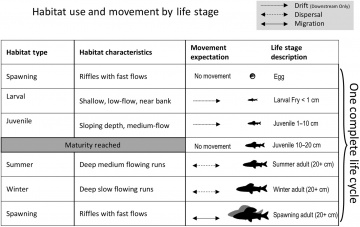Paper: A habitat connectivity reality check for fish physical habitat model results and decision-making for river restoration
Recently, RIBES Early Stage Researcher Henry Hansen from Karlstad University, together with RIBES associates Matthias Schneider and Tobias Hägele from SJE, published the paper " A habitat connectivity reality check for fish physical habitat model results and decision-making for river restoration". In a case study, they explore the effect of habitat connectivity on river restoration outcomes using European grayling and common nase as model species. They take in tto account habitat shifts during the life cycle of the fish, distance between habitats, and concludes that a perfect migration corridor does not necessarily provide habitat connectivity.
In the abstract they write:

- Fish physical habitat models are a tool for guiding restoration efforts in lotic ecosystems, but often they overestimate restoration outcomes because currently they do not incorporate habitat connectivity. This persistent issue can, in extreme cases, result in little or no improvement to fish populations after the restoration, wasting valuable conservation resources.
- We present a case study where practitioners applied a fish habitat model for multiple life stages of gravel spawning fishes to a 52-km stretch of the Iller River but did so at a microscale implementation by setting up a model based on cross sections with a maximum of 200 m distance from each other. This approach provided an opportunity to assess the connectivity of habitats for gravel spawning fishes, that is, European Grayling (Thymallus thymallus) and Common Nase (Chondrostoma nasus), integrating probabilities to find suitable habitats for all life-history stages and seasonal movements.
- We used the assessed habitat estimates (availability of distinct habitat types within reaches defined by the 200 m cross sections) to calculate the minimum distance a fish would need to overcome to change from one habitat type into the other as it hypothetically ‘grew up’ from egg to full spawning adult. This approach can be interpreted as a life cycle habitat check as it considers all habitat types that are necessary to fulfil the life cycle of gravel spawning fishes including their size, distance and flow direction-related orientation (e.g. larvae habitats only used when downstream of spawning areas).
- Our results show that the assumption of complete connectivity would require long movement distances for vulnerable life stages to find suitable habitat. This puts the high priority on the creation of migration corridors and passability of migration barriers in question. Without consideration of habitat types for all life stages of a species and their spatial context, restoration will not be successful. Shortly said: A perfect migration corridor does not necessarily provide habitat connectivity.
- We recommend the application of the habitat connectivity approach when predicting the effect of restoration measures and particularly setting the priority of measures for mitigation of fish migration.
Access the full paper here: Hansen, H. H., Schneider, M., & Hägele, T. (2023) A Habitat Connectivity Reality Check for Fish Physical Habitat Model Results and Decision-Making for River Restoration. Ecological Solutions and Evidence 4, no. 4 (2023): e12291. https://doi.org/10.1002/2688-8319.12291.
